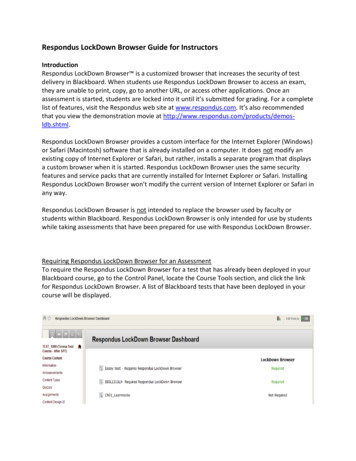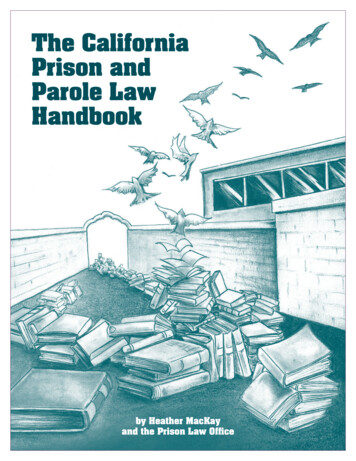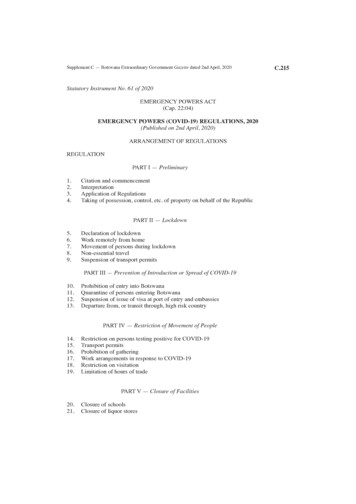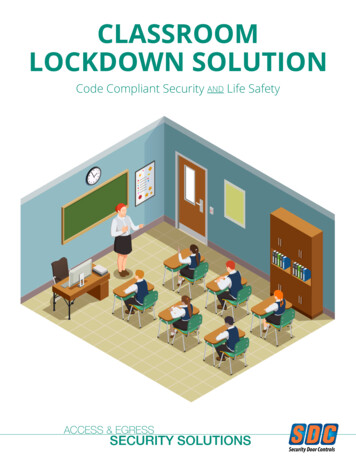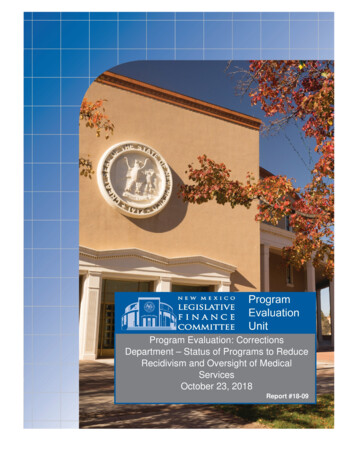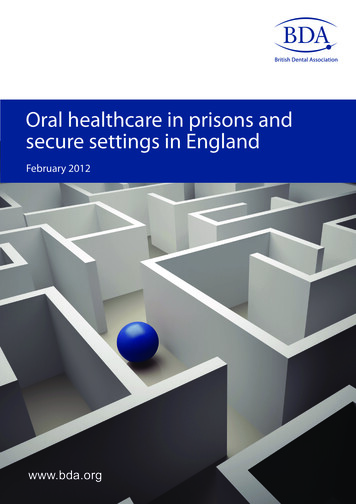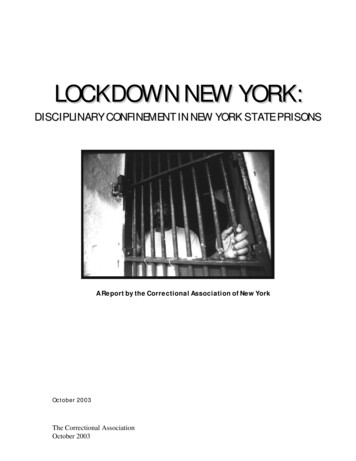
Transcription
LOCKDOWN NEW YORK:DISC IPLIN ARY CONFINEMEN T IN NEW YORK S TATE PRISONSA Report by the Correctional Association of New YorkOctober 2003The Correctional AssociationOctober 2003
TABLE OF CONTENTSI.EXECUTIVE SUMMARY2II.INTRODUCTION6III. BACKGROUNDOverview of Disciplinary Lockdown in New York StateMethodologyFactors Driving ConstructionCosts to Build and OperateThe Disciplinary ProcessCharges that Result in Disciplinary LockdownPortrait of Inmates in Disciplinary Lockdown99101214151719IV.AREAS of CONCERNHigh Number of Inmates in 23-Hour LockdownLength of SentencesPrevalence of Inmates with Serious Mental IllnessPsychological Effects of Extended IsolationAdditional Punishments: Deprivation Orders and the Restricted DietHigh Rates of Suicide and Self- HarmImpact on Correction OfficersDangerous Double-Celling ArrangementsChronic IdlenessAllegations of Correction Officer MisconductInaccessibility of Staff / Neglected InmatesBarriers to Health CareDirect Releases to General Population and Society2020212225282932343536373940V.WELL-RUN UNITS in NEW YORK41S-Block at Greene Correctional FacilitySpecial Housing Units at Shawangunk, Sing Sing, Sullivan and WoodbourneVI.PROGRAMS to IMPROVE or EXPANDProgressive Inmate Movement SystemPre-Residential Substance Abuse TreatmentSpecial Treatment Program for Inmates with Mental Illness43434445VII.OUT-of-STATE MODELColorado State Penitentiary46VIII. RECOMMENDATIONSThe Correctional AssociationOctober 2003501
EXECUTIVE SUMMARYThe findings from Correctional Association visits to nearly every disciplinaryhousing unit in New York – 49 visits to 26 lockdown units – reveal a disturbing picturecharacterized by emotional and physical distress, a reliance on warehousing instead oftreatment, high rates of mental illness, suicide and self- mutilation, low staff moral andunsafe working conditions for prison guards and administrative staff.New York prisons confine nearly 5,000 inmates, 7.6% of the total inmatepopulation, in highly restrictive disciplinary lockdown units for 23 to 24 hours per day.Minimal human contact occurs inside lockdown facilities where there is little natural lightand virtually nothing for inmates to do. The enforced idleness and reducedenvironmental stimulation can last for months or years and lead to severe psychologicaldebilitation.Some of the troubling realities of disciplinary lockdown are: By state estimate, nearly a quarter of the inmates in disciplinary lockdownsystem-wide are on the mental health caseload. In some units that we visited,over half of the inmates in solitary confinement were identified as seriouslymentally ill. Between 1998 and 2001, over half of the system’s 48 suicides occurred in 23- hourlockdown, although inmates in these units comprise less tha n 10% of the generalpopulation. Of the 258 inmates in our research sample, 44% reported previoussuicide attempts while in prison and 20% had prior admissions to the psychiatrichospital. Department figures show that incidents of self- harm rose by 66% between 1995and 2000. Of the 258 inmates we interviewed over one-third reported committingacts of self- mutilation while in prison. Unthinkable to outside observers, theDepartment issues misbehavior reports to inmates who attempt to kill or harmthemselves. Although there are nearly 1,000 New York inmates with mental illness indisciplinary segregation, the prison system’s sole psychiatric hospital, CentralNew York Psychiatric Center (CNYPC), has space for only about 200 inmatepatients. The CNYPC has not increased its capacity since it opened in 1980,although the prisoner population has tripled over that time. To punish inmates in lockdown who continue to violate rules, corrections officialsutilize increasingly punitive “deprivation orders,” most commonly time loss ofrecreation, loss of showers, and the use of mechanical restraints (handcuffs andwaist chain) during recreation. The most severe punishment is the restricted diet,The Correctional AssociationOctober 20032
or “the loaf” where inmates are fed a dense, binding, unpalatable one-pound loafof bread and a side portion of raw cabbage three times a day for seven daysstraight, followed by two days off. While the Department claims that deprivation orders are used infrequently and foronly the most incorrigible inmates, nearly half (49%) of the inmates in our samplereceived “deprivation orders” for violating rules while in lockdown. Forty-onepercent reported receiving four or more. Between 1997 and 2000, New York built ten high-tech, total lockdown facilities,representing the most dramatic expansion of high-security housing in statehistory. Construction costs alone ran to 238 million. If their prison sentence ends before their term in disciplinary confinement,prisoners are released, without any reorientation program, directly from theisolation of a disciplinary housing unit to the community. Disciplinary confinement often takes a heavy toll on correction officers. Officersin some units are stabbed, spat at, assaulted or “thrown at.” Some officers useantidepressants to cope with the stressful and depressing nature of the job. New York’s lockdown units provide few meaningful programs in which inmatescan engage, no jobs to perform, or opportunities for socialization to determinetheir preparedness for release to general population or society.The Department has demonstrated a capacity for responding positively to thegrave problems plaguing NYS’s lockdown units: Some disciplinary units, notably those at Greene, Shawangunk, Sing Sing,Sullivan, and Woodbourne Correctional Facilities, are markedly calm and quietand commended by officers and inmates. Common to these cellblocks are thesmall number of inmates, an experienced and attentive correctional staff, regularrounds by mental health personnel, and sufficient coordination between correctionofficers and counselors. Some lockdown units offer a “behavior modification” system, known asProgressive Inmate Movement System (PIMS), that enables prisoners to earn timecuts in disciplinary confinement. Along with the Office of Mental Health, the Department has developed a smallprogram for inmates with mental illness that provides them with mental healthservices and enables them to earn their way out of lockdown. Known as STP forSpecial Treatment Program, the initiative was piloted at Attica, recently expandedto Five Points, and serves a total of 45 inmates.The Correctional AssociationOctober 20033
PRINCIPAL RECOMMENDATIONSThere is great potential for misuse of authority, violation of policies, and abuse ofboth inmates and staff in lockdown facilities. Lacking extraordinarily carefulmeasures to mitigate against these factors, these units can become breeding groundsfor cruel behavior and callous indifference to human suffering. The Governor andother state policymakers should take bold action to address the grave deficiencies thatcharacterize conditions inside these prisons within New York’s prison system. Create a permanent, independent oversight board with the authority tomonitor conditions in 23-hour lockdown units. The review board shouldconduct monitoring visits, make unannounced inspections, investigate complaints,evaluate compliance with directives and report findings and recommendationsannually to the governor, the legislature and the public. Regularly review the inmate death reports published by the New York StateCommission of Correction and implement its recommendations. Thesecarefully considered recommendations often go unheeded, because no entityrequires their implementation. The Governor’s Director of Criminal Justiceshould review the Commission’s reports and hold prison and mental healthofficials accountable for making necessary reforms. Provide appropriate housing for mentally ill prisoners by enacting the billintroduced by Assemblymember Jeffrion Aubry (D-Queens), Chair of theCorrections Committee, that prohibits confining inmates with serious mentalillness in 23- hour lockdown units and provides the resources for creatingcorrectional psychiatric facilities. Institute a suicide prevention program in every 23-hour lockdown unit,including keeplock. A properly administered suicide prevention program couldmean the difference between life and death for inmates in 23- hour lockdown. End practices of mechanically restraining inmates during recreation, ofpunishing inmates with a re stricted diet of bread and raw cabbage, and ofpenalizing inmates for acts of self-harm. Provide meaningful programs to inmates in lockdown. The state can increasepublic and prison safety by requiring inmates to participate in group activity priorto their release. No inmate should be released directly from lockdown to generalpopulation or society before participating in congregate activities that helpprepare them, and determine their readiness, for release. Restrict the use of disciplinary lockdown to inmates who commit seriousoffenses. The National Institute of Corrections of the U.S. Department of Justiceasserts that lockdown facilities are inappropriate for the “nuisance inmate.”The Correctional AssociationOctober 20034
DOCS should limit the use of long-term disciplinary lockdown to the most seriousdisciplinary cases. Avoid double-celling of lockdown inmates to the extent practicable, includingusing cell-blocks in the new high-tech prisons for drug treatment programs orother purposes, and take all necessary steps to ensure that inmates with a capacityfor violent behavior are not double-celled. Allocate the resources needed to expand the capacity of CNYPC so that theprison system can better accommodate the treatment needs of severely mentallyill inmates. Increase funding for the Special Treatment Program that providestherapeutic services for mentally ill inmates in lockdown units. The 45-bedcapacity of this well-regarded program is clearly insufficient to meet the needs ofthe nearly 1,000 inmates in disciplinary lockdown on the mental health caseload. Appoint a task force of seasoned correction officers to identify ways toimprove the safety, morale and training of security staff in 23- hour lockdownunits. The recommendations of this task force should be reported to the governorand legislature and translated into programs and policies.The Correctional AssociationOctober 20035
II.INTRODUCTIONImagine, for a moment, the following scenario: With your hands cuffed in frontof you and attached to a chain around your waist, a correction officer leadsyou down a dimly lit cellblock and stops in front of an empty cell. He instructs you to stepinside and then locks the thick metal door behind you. He tells you to place your handsthrough the “feed-up” slot in the door so that he can remove the restraints without risk ofinjury or escape.You turn and survey your surroundings: a cell, the size of an average bathroom,with concrete walls and a concrete floor. Iron bars at the back face a corridor, acrossfrom which are tall windows that allow filtered rays to penetrate your cell—your onlysource of natural light. A few feet from the metal bed, a stainless steel toilet and sink areaffixed to the floor. You sit on the thin mattress and wonder how you’ll live in this barrencage.Until a book cart comes by—maybe the next day, maybe not—all you have to readis the Special Housing Unit manual telling you what to expect while you are there: nophone calls, no programs, no group interaction with other inmates and no out-of-cellmovement except an hour a day of legally-mandated recreation. If you decide to go torecreation, you will be “mechanically restrained” with handcuffs and a waist chain asyou are escorted to an empty outdoor cage. If you have a history of violence, you willremain shackled during recreation. Even if the temperature outside is below freezing, youwill not be allowed to wear gloves or a hat. There is no equipment in the rec pen, noteven a ball.At dinnertime, a rubber-gloved hand pushes a meal tray through the feed-up slotin your door. You cannot see the face of the person serving your food. As evening turns tonight, you lie down to sleep but cannot. The shouts of men in neighboring cells ricochetdown the corridors and bounce off the concrete walls, creating an eerie din. From thewild ranting of a particular inmate, you can tell that he has lost his mind.Hours later, you wonder what time it is but have no way of knowing since watchesare not allowed and no clocks are in sight. The newspaper the correction officer givesyou the next day is a week old. Your only contact with the outside world is through asingle earphone you plug into a wall jack connecting you to a few radio stations chosenby the facility. It occurs to you how little control you have left over your world: Youcannot choose what you hear, what you read, what you see. Your surroundings have beenreduced to shadows and steel, your life to a nightmarish monotony. You will remaininside this prison within prison for over a year, along with several thousand otherinmates in the custody of the New York State Department of Correctional Services(DOCS).The Correctional AssociationOctober 20036
There is increasing awareness today of America’s grim incarceration statistics:Over two million citizens are behind bars, more than in any other country inthe world. More than six million people are under some form of correctional supervision,including prison, parole or probation. America constitutes just 5% of the world’spopulation but houses 25% of its prisoners. “Never before have so many Americans—roughly 14 million—faced the likelihood of imprisonment at some point in their lives,”reported Newsweek’s November 13, 2000 cover story, “America’s Prison Generation,”shortly after the United States surpassed Russia as the country with the highest rate ofincarceration.A trend less known to people outside the criminal justice community is theproliferation of ultra-maximum-security “lockdown” units, highly secure prisons withinprisons in which inmates are confined 23 hours a day. In these stark facilities, allmovement is monitored by video surveillance and assisted by electronic door systems.Special alarms, cameras and security devices are everywhere. Living conditions includeeither solitary confinement or double-celling, where two men are forced to share limitedliving space around the clock. Few programs are provided to inmates in ultra- maxprisons. Simply enduring the extraordinary degree of idleness is one of the most difficultaspects of life in disciplinary lockdown, as there is virtually nothing for prisoners to do.Like animals in a cage, inmates are “cell- fed” through feed-up slots in thick metaldoors. Most facilities initially limit showers to just three a week. The number of phonecalls inmates can make is sharply restricted. Visits are conducted behind Plexiglas ormesh-wire barriers and limited to one visit a week. Whenever prisoners leave their cells,they are mechanically restrained with handcuffs and a waist chain, and leg irons if theyare considered seriously violent or escape-prone. Some inmates remain handcuffedthroughout their visits (thus, they cannot embrace or hold hands with their visitors) andsometimes during their one hour of recreation.The psychological effects of punitive isolation are well documented in theliterature. Dr. Stuart Grassian, a psychiatrist who has evaluated the effects of solitaryconfinement on over 100 prisoners in various state and federal prisons, including NewYork facilities, has concluded that conditions in lockdown can cause such symptoms asperceptual distortions and hallucinations, massive free-floating anxiety, acute confusionalstates, delusional ideas and violent or self-destructive outbursts, hyper-responsivity toexternal stimuli, difficulties with thinking, concentration and memory, overt paranoia,and panic attacks. 1Designed for inmates who violate prison rules or whom correction officials deemthreats to security, lockdown units are attractive because they are easier to manage and, insome jurisdictions, cheaper to operate than regular prisons. With no congregate activity1Declaration of Dr. Stuart Grassian, Eng v. Coughlin (80-CV-385S, undated).The Correctional AssociationOctober 20037
and little out-of-cell movement, contact between inmates and staff is minimal. “Allprisons should be made this way,” a deputy superintendent told us on a visit to NewYork’s newest lockdown unit, Upstate Correctional Facility. Lockdown units are alsoattractive to politicians seeking to burnish their tough-on-crime credentials. As theNational Institute of Corrections notes, “The fact that such facilities often are politicallyand publicly attractive . . . also has had a role in their increase nationwide. They havebecome political symbols of how ‘tough’ a jurisdiction has become.”2In 1984, only one prison in the United States, the federal penitentiary in Marion,Illinois, was a total lockdown facility. After a series of catastrophes at what was then ageneral population prison—numerous escape attempts, serious assaults on inmates andstaff, and the killing of two correction officers (on the same day in October 1983)—astate of emergency was declared. The prison was placed on permanent lockdown status,which continues today. Since then, the majority of states have built total lockdownfacilities, which together hold more than 20,000 prisoners, or approximately 2% of thenation’s total prison population. 3New York has joined this trend. Between 1997 and 2000, the state built ten hightech, total lockdown facilities, representing the most dramatic expansion of high-securityhousing in state history. New York opened its first total lockdown facility at Southport, in1991. Together, these modern, freestanding facilities can house up to 3,788 inmates,though they have operated under capacity since they opened. In some jurisdictions, thesefacilities would be called “supermaxes,” but New York correction officials resist thatterm. Either way, conditions are basically the same: 23- hour lockdown, enforced idlenessand extreme social isolation.Total lockdown units are among the most isolated institutions in the country. Fewoutsiders are permitted access; little public oversight exists. The inmates housed in theseprisons within prisons tend to be the most marginalized individuals in the correctionallandscape—a hidden population isolated not only from society but from other inmates inthe system. Some are illiterate; many are cognitively impaired or mentally ill. In the NewYork State prison system, DOCS’ figures show that nearly a quarter (23%) of inmates indisciplinary lockdown units system-wide are on the mental health caseload, a proportionthat independent correctional experts describe as alarmingly high.Not surprisingly, little is known about inmates in total lockdown units, how theirexperience in the darkest recesses of the prison system affects them or how they endure.Criminologist Norval Morris, who has written extensively about supermax confinement,has noted: “We know little from research on who is sent to these units, why and for how2National Institute of Corrections. (1999). SupermaxPrisons: Overview and General Considerations.Longmont, CO: U.S. Department of Justice, National Institute of Corrections.3King, R. D. (1999). The rise and rise of supermax: An American solution in search of a problem?Punishment and Society, 1, 163-186.The Correctional AssociationOctober 20038
long; or the effects of supermax confinement on people with mental illness.”4 This reportattempts to address these and other questions by examining New York’s dramaticexpansion of disciplinary lockdown in recent years and how the conditions ofconfinement affect the nearly 5,000 prisoners inside.III.BACKGROUNDOverview of Disciplinary Lockdown in New York StateCurrently, approximately 5,000 inmates are confined in 23-hour disciplinarylockdown in New York. 5 Following are the three types of lockdown:1. Keeplock. Inmates on keeplock are either confined to their cells or housed in aseparate cellblock in the prison. While keeplock is considered the least restrictiveform of disciplinary housing because inmates are permitted more personalproperty and the stays tend to be shorter, keeplock is still governed by the sameDepartment directive (4933) that applies to inmates in Special Housing Units.2. Special Housing Units. Special Housing Units (SHUs) are designatedcellblocks or freestanding buildings in most maximum-security and somemedium-security prisons. The majority of SHUs are located in old-stylemaximum-security prisons (Attica, Auburn, Clinton, Elmira, Great Meadow,Green Haven and Sing Sing), where cells tend to be dank and dimly lit, as theonly natural light comes from windows across a corridor. Most SHU cells havebars on the front or back of the cell; others are far more isolating, with threeconcrete walls and a thick metal door.3. High-Tech Lockdown Facilities. Representing the newest form of disciplinaryconfinement, these modern-day lockdown units are electronically- controlled,freestanding facilities with state-of-the-art video and aud io surveillanceequipment. New York has 11 such facilities: Southport and Upstate, whichconstitute entire prisons, and nine “S-Blocks” on the grounds of other facilities.Combined, they have a total capacity for housing 3,700 inmates:§700 beds at Southpo rt Correctional Facility, the state’s first totallockdown prison, which opened in 1991. Inmates are confined in singlecells with bars; recreation takes place in outdoor cages (one inmate percage) on facility grounds. For the first 30 days, all inmates remain4Kurki, L. and Morris, N. (2001). The purposes, practices and problems of supermax prisons. Crime andJustice, 28, 385-424.5DOCS figures on April 14, 2003 show a total of 4,981 inmates in disciplinary lockdown. On that date,there were 1,529 inmates in keeplock, 432 in Special Housing Units, and 3,020 in high-tech total lockdownfacilities.The Correctional AssociationOctober 20039
shackled during their one hour of recreation. Southport is known byinmates and staff as an “end of the line” prison.§1,800 beds in S-Blocks, nine freestanding facilities with a capacity to hold200 prisoners each. In cells measuring 105 square feet, two men areconfined together 24 hours a day behind a thick metal door with a smallwindow. Recreation is provided in small outdoor cages attached to theback of the cells. DOCS opened all nine S-Blocks between 1998 and 2000on the grounds of the following medium-security correctional facilities:Cayuga, Collins, Fishkill, Gouverneur, Greene, Lakeview, Marcy, MidState and Orleans.§1,200 beds at Upstate Correctional Facility, opened in 1999, with acapacity for 1,500 inmates, housed two men to a cell. Of these inmates,1,200 are in disciplinary lockdown status; 300 are on general confinementstatus and work in the prison. As in the S-Blocks, recreation cages areaffixed to the outside wall of the cells.MethodologyOur research was prompted not only by the dramatic expansion of disciplinarylockdown units in recent years, but by a growing number of letters and phone calls frominmates, family members and attorneys suggesting serious problems. Most frequentclaims included the unfair nature of disciplinary hearings, the trivial charges that result indisciplinary confinement, the length of sentences, forced partnerships with dangerouscellmates, and inadequate access to medical and mental health services. A significant areaof concern is the high number of inmates with mental illness confined in disciplinarylockdown. Department figures reveal that 23% of inmates in disciplinary lockdown unitssystem-wide are on the mental health caseload.To explore these and other issues, we conducted an extensive review of theliterature, obtained data and policy information from DOCS and the Office of MentalHealth (the state agency responsible for mental health care in the prisons), and reviewedinmate death reports produced by the New York State Commission of Correction (agovernment oversight agency). We interviewed current and retired New York Statecorrection officers, superintendents and mental health clinicians; inmate family members,ex-offenders and attorneys; and psychiatric, legal and correctional experts throughout thecountry.The bulk of our findings are based on visits to lockdown units throughout the stateand structured interviews with inmates housed in them. In preparation for this report, weconducted 258 inmate interviews 6 and made 49 site visits to lockdown units in thefollowing 26 prisons:6During site visits conducted between 1998 and 2001, we interviewed inmates using a checklist ofquestions. In 2002, we designed a more detailed, structured survey to collect data about inmates’The Correctional AssociationOctober 200310
Correctional Facility/Lockdown Area .19.20.21.22.23.24.25.26.Arthur Kill: SHUAttica: SHU and KeeplockAuburn: SHUClinton: SHU and KeeplockCollins: S-BlockCoxsackie: SHU and KeeplockDownstate: SHUEastern: SHUElmira: SHU; KeeplockFive Points: SHUFishkill: S-Block and SHUGreat Meadow: SHUGreen Haven: SHUGreene: S-BlockMarcy: S-BlockMid-State: S-Block and SHUOrleans: S-BlockOtisville: SHUShawangunk: SHUSing Sing: SHUSouthport: All cellblocksSullivan: SHUUpstate: All cellblocksWashington: SHUWende: SHUWoodbourne: SHUYear(s) Visited20021998, 2000, 20021999, 20012001, 200220001998, 20021998, 20021999, 20021998, 2001, 200220021998, 20012000, 20021999, 2001, 2002, 20031998, 200219982002199820022000, 20032000, 20032001, 2002, 20021998, 20022001, 200220001998, 2000, 20022003Visits were conducted by members of the Correctional Association’s PrisonVisiting Committee, which includes staff and board members, lawyers, psychiatrists,psychologists, physicians, correctional experts, a retired corrections captain, ex-offendersand concerned citizens. Committee members toured the cellblocks, interviewed prisoners,reviewed logbooks and spoke to correction officers on the units.Limitations of the research. As with all research projects, particularly thoseconducted in highly restrictive environments such as prison, there were certain limitationswith the research. Interviews with inmates, while conducted out of earshot but withineyesight of correctional staff, were not entirely confidential, a factor that may haveinfluenced their responses. In addition, survey data were self-reported. The possibilityexists that inmates over-reported or under-reported information, thinking that in ourperceptions of and experiences in lockdown. Containing approximately 40 questions, the survey wasdesigned with input from correctional and mental health professionals and former inmates. Weadministered the survey to 258 inmates in disciplinary lockdown in the following 12 prisons: Attica,Clinton, Elmira, Five Points, Great Meadow, Green Haven, Sing Sing, Southport, Sullivan, Wende,Woodbourne and Upstate. Data were coded and analyzed using SPSS (Statistical Package for the SocialSciences). A tabulation of the survey data is presented on page 19.The Correctional AssociationOctober 200311
capacity as outsiders we might have influence over their custodial status. We took stepsto mitigate these factors by informing inmates of the nature and scope of the research,emphasizing that we had no influence over their status within the correctional system,and assuring them that the information they provided was confidential. The vast majorityof inmates were eager to participate and spoke with surprising candor, even whendiscussing highly sensitive or incriminating information such as their criminal activity inprison, psychiatric history, and victimization by other inmates. Finally, due to time andresource constraints, we did not elaborate on the issues specific to female inmates in 23hour lockdown units. Although women represent a very small proportion of the totallockdown population, their experiences warrant separate and deeper analysis than wewere able to provide.Despite these limitations, however, we believe that the broad scope of the study,extending to nearly every lockdown unit in the state, and the large number of inmatessurveyed, increase the validity of our findings and the conclusions we have drawn fromthem.Factors Driving ConstructionTen of New York’s eleven lockdown facilities were constructed between 1997and 2000, representing the largest expansion of disciplinary housing in state history. Thefirst such facility to open was the 200-bed S-Block on the grounds of Marcy CorrectionalFacility in central New York. Over the next three years, eight more S-Blocks were built.In 1999, New York opened the 1,500-bed Upstate Correctional Facility inMalone, New York, a small town about fifteen miles south of the Canadian border.Upstate was New York’s 70th prison and the third correctional facility built in Malone,where inmates now constitute more than a third of the town’s population.Unlike the establishment of lockdown in Marion, Illinois, the build-up oflockdown units in New York was not precipitated by a catastrophic event. Rather, theconstruction was driven mainly by two factors: the need for more maximum-security cellspace and the availability of federal cash incentives in return for ending parole.Need for Additional Maximum-Security Cell SpaceAs the inmate population doubled from approximately 35,000 to 70,000 betweenthe mid-1980s and mid-1990s—consisting mainly of nonviolent, medium-security drugoffenders—DOCS handled the increase by building more prisons and doubling thehousing capacity in medium- security prisons through double bunking. Because the SHUsin medium-security facilities were not expanded, however, inmates who violated rulesserious enough to warrant disciplinary confinement were transferred to cells inmaximum-security prisons and placed on keeplock status. However, many of themaximum-security prisons were already filled to capacity.The Correctional AssociationOctober 200312
As a result, these maxi
The 45-bed capacity of this well-regarded program is clearly insufficient to meet the needs of the nearly 1,000 inmates in disciplinary lockdown on the mental health caseload. Appoint a task force of seasoned correction officers to identify ways to improve the safety, morale and training of security staff in 23-hour lockdown units.

